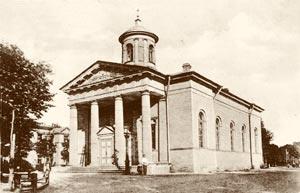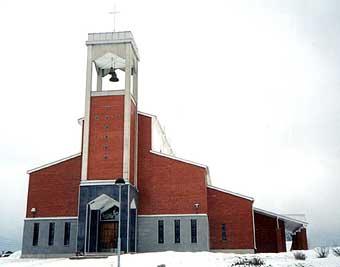Articles
/
Ethnic deportations
Ethnic deportations
Subject /
Ethnic culture
Ethnic deportations are forced resettlement carried out according to an ethnic signs. In 1935-36 in the Leningrad Oblast there were some activities on purging the zone of land with 22 kilometres wide at the border with Finland "from kulak and anti-Soviet elements". During these activities the citizens of Finnish nationality (exept the party members' families and the persons called up for the service in the Red Army) were deported mainly to the Vologda Region. After the beginning the Great Patriotic War when Finland supported Germany, in the end of August 1941 deportation of Finns and Germans of Leningrad and the Leningrad Oblast to Siberia and Kazakhstan was planned. Beginning of the siege of Leningrad didn't let carry out it. "Obyazatelnaya evakuatsya" ("The Compulsory evacuation") of Finns and Germans from Leningrad and unoccupied environs (including Oraniyenbaum bridgehead) was carried out in March 1942 (in accordance with the decree of the Council of War of the Leningrad Front No 00713). The German occupation authorities conducted deportation of population shortly before their retreating in the autumn 1943: Russians were deported to the Baltic States and Germany, Finnish speaking population (Finns of Ingermanlandia, Izhora, Votes) were deported to Finland. After withdrawal of Finland from the war (September 1944) repatriation of the Soviet citizens being on its territory began. The returning Finnish speaking residents of the Leningrad Oblast were forcibly accomodated in the Yaroslavl, Kalinin, Novgorod, Pskov, Velikye Luky regions (the decree of the State Defence Committee dated 19 November 1944 "About Resettlement of the Population of Ingermanlandian Origin Formerly Living in the Leningrad Oblast from Finland" . Some benefits to the IDPs (Internally Displaced People) (exemption from tax for the period from 1945 to 1946, giving loans for buying livestock and for building houses etc.) panned to give them but it was not made in full. The most of repatriates escaped from the places of deportation but lots of them settled in Estonia and Karelia because only the war veterans' families were allowed to live in the Leningrad Oblast (the direction of the People's Commissar Council dated to 19 September 1945). The restriction on living in the Leningrad Oblast was removed in the middle of the 1950s. According to the decree of the RSFSR Supreme Soviet "About Rehabilitation of the Finns of Russia" dated to 29 June 1993 all Acts passed in the period from the 1930s to the 1940s related to Finns of Russia were declared as "unlawful and expired". In the cemetery near Gakkovo Village (Kingisepp District) in 1989 a monument to the local people (Finns of Ingermanlandia, Izhora, Votes) died in the years of Stalin repression was placed. In addition, in S.Petersburg in Levashovo cemetery where the victims of terror 1937-38 were buried, some monuments to the Finns of Ingermanlandia (1994) and Germans of Russia (1998) were placed.
Authors
Chistyakov, Anton Yuryevich
Geography
Neighbouring Territories/Estonia
Neighbouring Territories/Finland
Leningrad Oblast, the/Kingisepp District/Gakkovo Village
Neighbouring Territories/Karelian Republic
Neighbouring Territories/Novgorod Oblast, the
Neighbouring Territories/Pskov Oblast, the
Neighbouring Territories/Vologda Oblast, the
Bibliography
Гильди Л.А. Судьба «социально-опасного» народа. (Засекреченный геноцид финнов в России и его последствия. 1930-2002 гг.). СПб., 2003
Мусаев В.И. Политическая история Ингерманландии в конце XIX-XX веке /В.И.Мусаев. – Изд. 2-е испр. и доп. – СПб.: Нестор-История, 2004. – 450 с.: ил., 252-339
Subject Index
Finns
Finns of Ingermanlandia
Germen
Izhora (Izhora men)
Russians
Vod (Votes)
Mentioned in articles:
|
hidden
|
Colonists (immigrants in Tsar Russia)
Colonists are a class group existed in the 18th - the early 20th century. Catherine II promulgated manifestoes (dated 4 December 1762 and 22 July 1763) allowed to foreigners to settle in Russia for rapid settlement of lands and development of... more
|
|
|
hidden
|
Germen
The Germans (their own native name is Deutsche) are an ethnic community which is a part of the polpulation of the Leningrad Oblast. The religious Germans are Lutherans and Catholics. The Germans are the main population of Germany. In Russian (in... more
|
|
|
|
hidden
|
Ingermanlandia
INGERMANLANDIA (Swed. Ingermanland, Rus. Izhora Land or Ingria), historic and cultural region in the western part of the Leningrad Oblast (Kingisepp, Volosovo, Lomonosov, Vsevolozhsk, Gatchina, Tosno, western part of Kirovsk Districts.) The western... more
|
|
|
|
hidden
|
Koltushi Rural Settlement
KOLTUSHI RURAL SETTLEMENT, a part of Vsevolozhsk District. Population: 9,000. In 1996–2005, it was an independent municipal entity Koltushi Volost, and since 1 January 2006 it has had the status of first-level municipal entity. It is located on the... more
|
|
|
|
hidden
|
Novosaratovka, a settlement of Germen-colonists
Novosaratovskaya colony (the present village of Novosaratovka of Vsevolozhsk District) is a settlement of Germans - colonists on the right bank of the Neva River. It was founded by immigrants from Württemberg and Brandenburg in 1765. In the 18th... more
|
|
|
hidden
|
Resettlements of the 1945 - 1950s
Resettlements of the 1945 - 1950s were migrations which were caused by political (eviction of some categories of citizens who were considered as unreliable, including the activities for cleaning up the frontier) and economical (the necessity of... more
|
|
|







